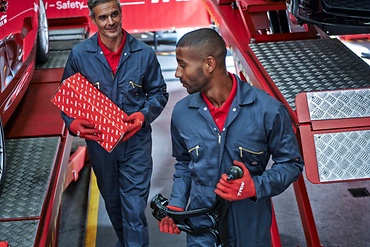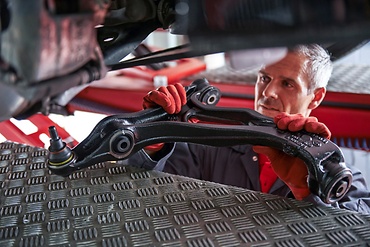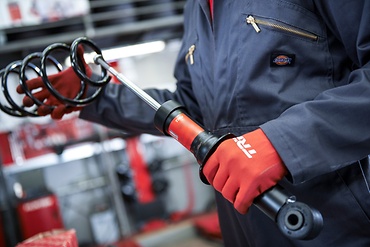Keep the wheels on the road
A simple definition of a vehicles suspension system could read as follows: "The suspension system of a vehicle refers to the components connecting the wheel of the vehicle to its chassis". Its primary task is to keep the wheels on the road and isolate the chassis of the vehicle from vibrations coming from irregularities and bumps on the road.
When the car is in motion, the suspension is exposed to:
- forces of gravity
- driving forces - reaction forces resulting from the bumpy roads
- lateral forces generated during cornering
- hot and cold temperatures
- debris
- water
Basic types of independent suspension
A vehicle’s front axle has three basic types of independent suspension:
- McPherson struts
- double wishbone suspension
- multi-link suspension
Each of these solutions can be supplied with a number of design variations. The McPherson strut is the most common solution due to its relatively simple construction. However, there are some disadvantages, such as limited travel or lack of flexibility on the king pin angle and camber angle and other setup specifications. These design limitations have made vehicle manufacturers increasingly eager to use multi-link suspension systems. This is particularly true in the premium segment; where vehicles often have significant weight and develop considerable speed. Users of such cars expect a very high level of comfort and road holding capability.
As with many new products being manufactured for passenger cars, multi-link suspension was first used in motorsport. Motorsport companies recognised that it kept the perpendicular position of the wheel to the road surface in almost any conditions - even during fast cornering. Having been updated with a number of components to improve comfort, the system has been adapted for everyday use.
Technical Information
A typical example of multi-link suspension is found on the front axle of the VW Passat B5. The basic elements in this system are two pairs of upper control arms (front and rear), two pairs of lower control arms, stub axle, stabilizer, connecting rods, shock absorbers and springs. All control arms are made of light alloys, and integrated ball joints. The mounting points for the control arms at the chassis allow for certain changes to the geometry of the wheel in line with the specifications from the vehicle manufacturer. These parts may take the form of a metal bushing vulcanized in rubber, which reduces vibration and noise. The design of the rear lower arm mount bushing is more complicated. It is a hydraulic bearing, featuring a membrane containing hydraulic fluid. Well designed metal-rubber bushings enhance the stability of the vehicle when cornering at high speeds and braking.
It’s easy to see that multi-link suspension features many more structural components compared to other systems, for example McPherson suspension. This means that multi-link suspension by nature of its design has a higher probability of component failure. Staff at service stations should have appropriate qualifications for diagnosing and troubleshooting faults arising in this type of suspension. Inspection of individual parts should be made during periodic inspections, or when the driver complains about noise coming from the vicinity of the suspension. Early detection and repair is very important because the individual suspension components work together and the failure of one component can cause rapid wear on the rest of the system. Furthermore, a broken control arm can result in significant change in geometry, causing deterioration in the car’s handling as well as faster, or more uneven, tire wear.
How-to-guide

The first step in diagnosing faults should be a visual inspection of specific elements. At this stage we estimate the condition of rubber caps that protect ball joints and metal-rubber sleeves. Finding damage to any of these components means that you have to replace the whole control arm.
The next step is to look for the presence of free play in the ball joints. Here, the best method is to examine the chassis at the test stand. The test stand plates force the wheel to move in all directions, allowing the mechanic to check the individual elements of the system for the presence of play. Damage to the joint can be recognized both by the presence of play and any occurrence of creaking noises while turning wheels or manipulating the suspension. Creaks, or cracks in the dust covers, are an early sign of wear. It means that water has got under the rubber seal, causing corrosion of the ball joint elements. The visual examination on a test stand can also detect any damage to the metal and rubber sleeves. Mechanics must be careful not to be too hasty to declare failure of those elements.
This is especially true for the hydraulic bearings found in the lower rear control arm on a VW Passat B5. Its specific design allows for relatively large arm movements relative to the body and an inexperienced mechanic may interpret it as damage to the sleeve. The condition of a multi-link suspension can also be examined without a test stand.
The examination is carried out by forcing the movement of individual elements using a lever (e.g. tire lever). This control should be performed when the suspension is under load (from an inspection pit or with the use of a drive-on lift), and when it is unloaded (for example using a two-column elevator). You need to be aware of the strength and direction of the forces acting on individual components. For example, play on the upper arms in the example of the VW Passat B5 is shown most effectively when the car’s weight is on its wheels and the steering wheel is turned. Another mechanic can then place his hand on the rubber bushings of the arms and feel the presence of any play in the ball joint. The lower front control arm is best examined on a vehicle which is lifted, by applying upward force on the head of the control arm.
Once you find the damaged parts you should be ready to replace them. The first step here is the accurate selection of new parts.
TRW is a leading designer and manufacturer of suspension components for both vehicle manufacturers and supply to the aftermarket. The company also offers catalogues, allowing wholesalers, stores and workshops an easy way to make the appropriate selection of the necessary parts.
The catalogs are available both in paper and electronic form. Accurate selection is very important, because at first glance there can be almost no difference between the individual parts designed for one vehicle. Also some small changes in dimensions can occur in different year models or model code. Both the user of the car and the mechanic performing repairs of suspension should bear in mind that vehicle suspension system has a significant impact on traffic safety.
The removal and installation of suspension components should be performed using appropriate tools. The use of crowbars and heavy hammers may cause damage to other components.
In order to remove the bolt which secures the upper control arms in the example of the VW Passat it may be necessary to use a special tool as this bolt is relatively long and secured tightly in the stub axle. Environmental factors such as water and salt often cause corrosion in this area. The tool allows for the upper control arm removal without the time-consuming disassembly of the vehicle stub axle.
After disassembling the old parts, we move on to the installation of the new ones. First clean the contact surface of the dust cover. If the dust cover is not cleaned water will drain into the ball joint through the capillary effect, and corrosion will follow soon after.
All nuts and bolts must be tightened at the right torque using new nuts. Over tightening the bolt can cause real difficulties when the time comes to remove them. Not only that, a bolt which has been over tightened undergoes more stress than it was designed to handle – which can cause a weakness and compromise the safety of the car. Bolts which are difficult to reach are more prone to damage, be sure to check whether they need replacing once removed.
It is very important to install the control arm mounting bolts to the vehicle when the suspension is under the load of the car and its wheels are in a natural position. Tightening them on a raised vehicle, when the suspension is not under load causes unwanted torsion strain in the metal-rubber elements.
This causes faster wear and damage to newly installed parts, possibly from the point of the assembly. Care must also be taken not to damage the rubber ball joint bushings.
After the repair an examination of suspension geometry must be performed. A final check of wheel alignment will find any other issues that could have been missed during the inspection (e.g. a slightly bent control arm), as the correct wheel alignment is not possible with these issues. It also ensures even tyre wear, and that the car will behave as designed. When returning the car to the customer, it is good practice to give them an overview of the operation of the suspension system. It is unacceptable to drive onto high curbs or over bumps at high speeds. This rule applies to all types of suspension, but the multi-link suspension system is particularly susceptible to damage resulting from improper use.
Conclusion
In this article we have described the principles of operating and repairing multi-link suspension on a VW Passat B5, however the service methods can be used for other vehicles equipped with this suspension system.
Finally, it is a widely held belief that multi-link suspension systems have a high failure rate. While this type of suspension is susceptible damage from improper use, there are a number of other factors to consider. Some believe there are durability issues for parts within the system. This, however, applies mainly to low quality spare parts offered on the aftermarket. Other factors adversely affecting the sustainability of these suspension systems are very bad quality roads and mistakes made during repair and maintenance.
ZF Aftermarket provides high quality components for vehicle manufacturers and for authorised service stations. The use of high-quality spare parts from aftermarket suppliers who are also involved in the research and development of the systems for vehicle manufacturers, will ensure optimum comfort and excellent driving performance for cars with multi-link suspension.
ZF Aftermarket product range
Discover the complete portfolio of suspension systems in our product catalog.


